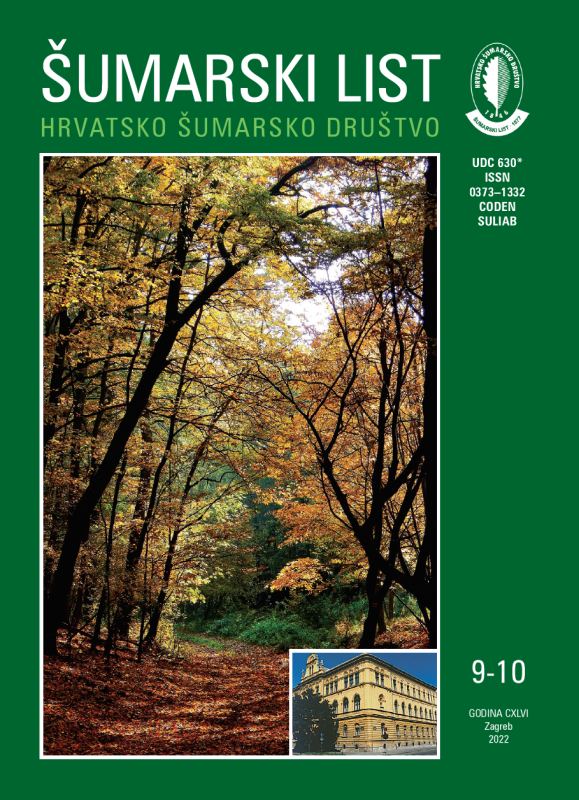
broj: 9-10/2022
pdf (15,8 MB) |
|
||||||||||||||
| RIJEČ UREDNIŠTVA | ||
| Uredništvo | ||
| Forests in the service of decentralisation and demographic recovery of Croatia pdf HR EN | 385 | |
| Editorial In the last decade, and especially in the past several years, the forestry profession has expressed concern for the state of forest ecosystems and the most valuable tree species. Namely, there is no species that is not under pressure from both old and new pests and diseases, which, in synergy with climate change, significantly reduce their vitality. For example, narrow-leaved ash, an important component of lowland forest stands, has already reached a critical stage of dieback. In our editorials we have frequently discussed the above issue, giving importance to all moves at the global and national level that are aimed at taking care of the great forest wealth in the Republic of Croatia. The Croatian media has recently been addressing the results of the 2021 population census. This has again put demographers in the centre of attention: they have been repeating the same story for decades, yet the decision makers do not take any heed. We may also draw a parallel with our decade-long story about the name of the competent ministry, and particularly about the attitude of the line ministry towards the forest, a resource that covers almost half of the country. Interestingly, demographers have also noticed the role of the public enterprise Croatian Forests, which manage state forests over the entire state territory. They propose decentralisation: “Today, the company Croatian Forests manages forests over the entire territory of Croatia, which is, conditionally said, centralised. Management should really be left to the local communities so that they bear the responsibility, but also have the same authority.” For example, in the Gorski Kotar region, where over 70 percent of the territory is covered with forests, the seventies and eighties of the 20th century was the period in which forestry was aimed at fostering the prosperity of the local community, as well as developing and raising the living standard of the people and the region. Today, it is an area affected by depopulation, while the forest resources at its disposal are either not used or are used elsewhere. A similar story is true for Slavonia, which possess the most valuable commercial forests, but which generate added value further from the place where they grow. This wealthy region has recently recorded the most severe emigration. Can the above trend be reversed? The adoption of strategic plans and their implementation should be based on comparative advantages of a certain region. We believe that focusing only on the management of raw materials without management of space and without strategic employment of personnel puts the rural areas of Croatia in an even more unfavourable position and leads to increased depopulation of the area. Economic policies which favour close interest groups have already taken their toll. Generous incentives from European funds motivate users to instantly engage in a certain activity, but the ultimate goal of increasing production is usually not met. Quite frequently, the beneficiaries of funds do not even live in the area for which the funds have been allocated. The Forest Acts and the Agricultural Land Act provide for the demarcation of forest and agricultural land according to their natural state and harmonisation with the land registry. Their implementation would facilitate the management of forests and eliminate problems arising from leases of large areas for grazing, the results of which highly questionable. Regrettably, this vital prerequisite for better management of space and for retaining, and even increasing the number of inhabitants in it, has not been fulfilled. Similar to other segments, years go by, but the laws and strategies set out by the goals are not implemented. The organisation of forestry in some neighbouring countries may offer answers to our questions. Austrian and Hungarian forestry companies are not engaged only in the production and sale of wood assortments: their activities are also related to renewable energy sources and nature protection, which expands the possibility of employment for the local population. Ultimately, their foresters have better income and higher living standard. Editorial Board | ||
| IZVORNI ZNANSTVENI ČLANCI | ||
| Tomislav Poršinsky, Zdravko Pandur, Zoran Bumber, Mihael Lovrinčević, Branko Ursić, Andreja Đuka | UDK 630* 312 (001) https://doi.org/10.31298/sl.146.9-10.1 | |
| Dimensional and mass characteristics of forwarders pdf HR EN | 387 | |
| Ping Qin, Ying Huang, Wenjun Zheng, Haitao Yu, Qing Zhang, Zhiyuan Xie, Yangyang Gao, Yichuan Bu, Yu Gan | UDK 630* 231 (001) https://doi.org/10.31298/sl.146.9-10.2 | |
| Factors of Natural Regeneration of Platycladus orientalis (L.) Franco in Guilin, China pdf HR EN | 403 | |
| Emrah Erdog˘an, Hayati Zengin, Mehmet Özcan, Ahmet Salih Deg˘ermenci, Necmi Aksoy | UDK 630* 232.4 (001) https://doi.org/10.31298/sl.146.9-10.3 | |
| Plant diversity indices for trojan fir stands in Aladag¨ region of Bolu pdf HR EN | 415 | |
| Vladimir Petković, Dane Marčeta, Igor Potočnik | UDK 630* 319 https://doi.org/10.31298/sl.146.9-10.4 | |
| Optimization of primary forest accessibility in high forests with natural regeneration pdf HR EN | 427 | |
| PRETHODNO PRIOPĆENJE | ||
| Milan Pernek, Marta Kovač, Andrija Jukić , Tomislav Dubravac, Nikola Lacković, Carrie Brady | UDK 630*459+111.8 https://doi.org/10.31298/sl.146.9-10.5 | |
| Acute oak decline (AOD) new complex disese on holm oak (Quercus ilex L.) and possibilities of spread on other oak species in Croatia pdf HR EN | 439 | |
| Slavko Mladenović, Milan Malinić, Boris Radić, Dragica Vilotić, Srđan Stamenković, Dragan Gačić | UDK 630* 156 https://doi.org/10.31298/sl.146.9-10.6 | |
| Monitoring of reintroduced red deer in the area of Tara (Western Serbia): incidence of bark stripping within an acclimatisation enclosure and postrelease movements pdf HR EN | 447 | |


